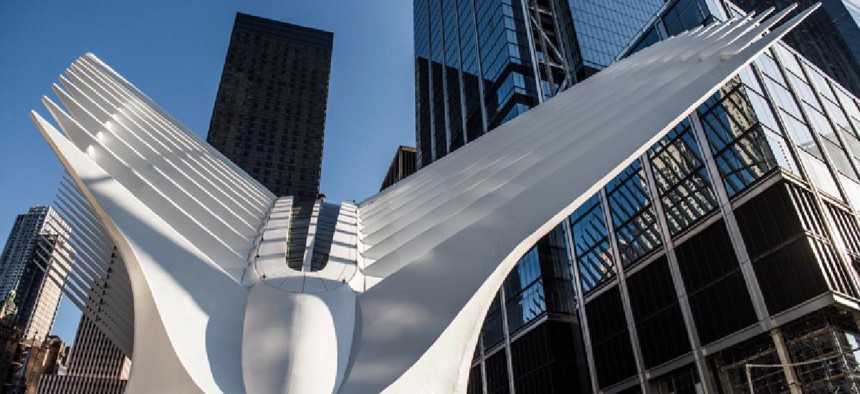Established in 1921 the Port Authority of New York and New Jersey (Port Authority) supports the region’s passenger and freight transportation systems through interstate bridges and tunnels, a rail transit system (PATH), bus terminals, airports, and seaports. In addition, the agency is a large commercial landlord, owning the World Trade Center. The Port Authority has no power to tax; instead, the agency raises funds from user fees and rentals, capital contributions from the federal government and other sources, and borrowing for capital projects. The Port Authority’s 2017 budget projects $5.2 billion in expenses and $583 million in net income, which the agency intends to invest in its facilities as pay-as-you-go capital. The overall budget conceals an important fact: bridges, tunnels, and airports generate revenues that subsidize the activities that lose money, namely PATH, the bus terminals, seaports, and for now, the World Trade Center.
2017 Budget and Financial Plan
The Port Authority’s most recent five-year financial plan, proposed in November and starting with the fiscal year in January 2017, projects $5.8 billion in revenue in 2017. The largest single line-item, almost 30 percent of total revenue, is $1.7 billion from tolls charged at the Authority’s bridges and tunnels. Approximately $2.6 billion collectively comes from the airports in the form of rents, fees, and parking charges. Rents collected at the World Trade Center ($240 million) and the Authority’s seaports ($222 million) each account for less than 5 percent of revenues. PATH fares account for $188 million, approximately 3 percent of total revenue.
Non-operating income includes aid in construction—primarily from capital grants made by the federal government and payments by Port Authority tenants to support construction and development of leased spaces—totaling $307 million. It also includes airport facility charges ($258 million) based on passenger traffic, which may only be used for federally-approved airport improvements.Expenses are expected to total $5.2 billion in 2017 and are comprised of operating expenses, depreciation, and interest on long-term debt. Operating expenses are projected to surpass $3.1 billion; half, or nearly $1.6 billion, will support aviation operations. An additional $460 million is to be spent operating tunnels, bridges, and terminals (15 percent). PATH and the World Trade Center, $350 million and $324 million respectively, each account for approximately 10 percent of operating expenses, while $172 million supports seaports (5 percent).
Depreciation, which reflects the steady and ongoing use of facilities and equipment, is budgeted to exceed $1.2 billion. Interest expense on long-term debt is $859 million.
The Port Authority projects a net income of $583 million in 2017, and its annual net income is projected to reach $900 million by 2021, growing 11.5 percent annually on average. This projection assumes no fare or toll increases. Operating expenses are projected to grow 1.8 percent annually on average, more slowly than between 2012 to 2016, when they grew 3.3 percent annually as the Port Authority completed construction of World Trade Center-related projects.
Winners and losers
The overall net income masks important internal cross-subsidies at the Port Authority. The agency relies on two of its business lines—Aviation and Tunnels, Bridges, and Terminals—to mitigate losses at other operations. A few facilities have outsized effects on Authority revenues and expenses. Just six facilities—the three Hudson River crossings (George Washington Bridge, Lincoln Tunnel, and Holland Tunnel) and the three major airports (John F. Kennedy International, Newark Liberty International, and LaGuardia)—account for three-fourths of all Port Authority revenue. These facilities pay their own operating expenses and generate additional revenue to subsidize the operations of the rest of the agency.
The biggest “loser” is the World Trade Center, for which a net loss of more than $600 million is projected in 2017. PATH is expected to lose $275 million despite more than $175 million in capital contributions, grants, and other non-operating revenues. The seaports are projected to lose a modest $38 million.
The Citizens Budget Commission (CBC) has recommended changes at PATH and the Port Commerce business lines to reduce deficits. Unlike most other U.S. transit systems PATH relies solely on passenger fares and a cross-subsidy from motorists using the Authority’s bridges and tunnels. CBC recommends a more equitable financing model that includes tax subsidies, such as sales or property taxes, covering PATH’s service area. In the Port Commerce business line, CBC recommends the Authority consider closing and repurposing underutilized and unneeded seaports in Brooklyn to concentrate maritime activities at more productive ports on the other side of the Hudson River.
Consistent with CBC’s strategies, the panel on Port Authority reform (a subcommittee of Port Authority Commissioners appointed by the two Governors in 2014) advocated the repurposing, redeveloping, or selling of underperforming facilities outside the scope of the bi-state agency’s mission. (The Port Authority has begun divesting of non-essential assets, but more divestitures may be in store.) Reducing losses deliberately and promptly is vital if the Port Authority is to continue to fulfill its mission to keep the region moving and provide the capital investment needed to maintain and expand its transportation infrastructure.


